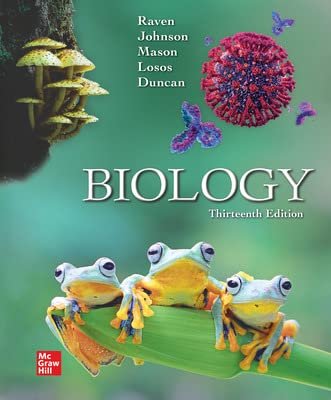Test Bank for Campbell Biology 11th Edition
Chapter 6 A Tour of the Cell
6.1 Multiple-Choice Questions
1) Which of the following is the smallest structure that would most likely be visible with a
standard (not super-resolution) research-grade light microscope?
A) mitochondrion
B) microtubule
C) ribosome
D) virus
Answer: A
Bloom’s Taxonomy: Knowledge/Comprehension
Section: 6.1
2) One primary advantage of light microscopy over electron microscopy is that ________.
A) light microscopy provides for higher magnification than electron microscopy
B) light microscopy provides for higher resolution than electron microscopy
C) light microscopy allows the visualization of dynamic processes in living cells
D) light microscopy provides higher contrast than electron microscopy
Answer: C
Bloom’s Taxonomy: Knowledge/Comprehension
Section: 6.1
3) In the fractionation of homogenized cells using differential centrifugation, which of the
following will require the greatest speed to form pellets at the bottom of the tube?
A) nuclei
B) mitochondria
C) chloroplasts
D) ribosomes
Answer: D
Bloom’s Taxonomy: Application/Analysis
Section: 6.1
4) What is the explanation for how a modern transmission electron microscope (TEM) can
achieve a resolution of about 0.2 nanometers, whereas a standard light microscope has a
maximum resolution of about 200 nanometers?
A) Glass lenses in light microscopes refract light, which reduces resolution.
B) Contrast is enhanced by staining with atoms of heavy metal.
C) Electron beams have much shorter wavelengths than visible light.
D) The electron microscope has a much greater ratio of image size to real size.
Answer: C
Bloom’s Taxonomy: Knowledge/Comprehension
Section: 6.1
2
Copyright © 2017 Pearson Education, Inc.
5) Which of the following would be the most appropriate method to observe the movements of
condensed chromosomes during cell division?
A) a hand lens (magnifying glass)
B) standard light microscopy
C) scanning electron microscopy
D) transmission electron microscopy
Answer: B
Bloom’s Taxonomy: Synthesis/Evaluation
Section: 6.1
6) Which of the following would be most appropriate method to observe and measure the size of
ribosomes in a eukaryotic cell?
A) a hand lens (magnifying glass)
B) standard light microscopy
C) scanning electron microscopy
D) transmission electron microscopy
Answer: D
Bloom’s Taxonomy: Synthesis/Evaluation
Section: 6.1
7) Which of the following would be most appropriate method to observe the three-dimensional
structure and organization of microvilli on an intestinal cell?
A) a hand lens (magnifying glass)
B) standard light microscopy
C) scanning electron microscopy
D) transmission electron microscopy
Answer: C
Bloom’s Taxonomy: Synthesis/Evaluation
Section: 6.1
8) A newspaper ad for a local toy store indicates that an inexpensive toy microscope available for
a small child is able to magnify specimens nearly as much as the more costly microscope
available in your college lab. What is the primary reason for the price difference?
A) The toy microscope does not have the same fine control for focus of the specimen.
B) The toy microscope magnifies a good deal, but has low resolution and therefore poor quality
images.
C) The toy microscope produces less contrast in the specimens.
D) The toy microscope usually uses a different wavelength of light source.
Answer: B
Bloom’s Taxonomy: Application/Analysis
Section: 6.1
3
Copyright © 2017 Pearson Education, Inc.
9) A newly discovered unicellular organism isolated from acidic mine drainage is found to
contain a cell wall, a plasma membrane, two flagella, and peroxisomes. Based just on this
information, the organism is most likely ________.
A) a nonmotile prokaryote
B) a motile bacterium
C) a motile archaea
D) a nonmotile eukaryote
E) a motile eukaryote
Answer: E
Bloom’s Taxonomy: Application/Analysis
Section: 6.2
10) Which of the following frequently imposes a limit on cell size?
A) the absence of a nucleus
B) the number of mitochondria in the cytoplasm
C) ratios of surface area to volume
D) the volume of the endomembrane system
Answer: C
Bloom’s Taxonomy: Knowledge/Comprehension
Section: 6.2










Reviews
There are no reviews yet.